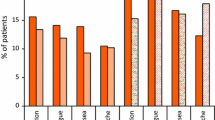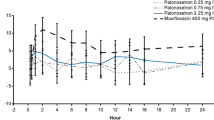Abstract
Granisetron is a highly potent and selective 5-hydroxytryptamine3 (5-HT3) receptor antagonist indicated for the prevention of cytotoxic-induced nausea and vomiting. Clinical trials have demonstrated granisetron to be effective and well tolerated at a standard dose of 40 μg/kg or 3 mg given i.v. as a 5-min infusion. In this study, the efficacy and safety of granisetron given as a 30-s infusion was assessed. A total of 21 patients, scheduled to undergo chemotherapy, received a single 3-mg i.v. dose of granisetron over 30 s, completed at 1 h before chemotherapy administration. Patients were allowed two further i.v. doses of granisetron at 3 mg within the 24-h assessment period. Changes from baseline values in vital signs were analysed prior to granisetron administration and at 30 s as well as 1, 10, 15, 30 and 60 min after granisetron administration. Holter ECG recordings were taken for 6 h prior to and 1 h after administration. No significant change was found in vital signs at 30 s or 1 min after granisetron infusion. There was a small but statistically significant fall in diastolic blood pressure as compared with baseline and a non-significant trend in favour of a reduction in heart rate at 10 and 15 min. No ECG abnormality was recorded post-infusion that had not been present pre-infusion. None of these changes was considered to be clinically relevant. The treatment was well tolerated. The most frequenctly reported adverse events were constipation (n=6) and headache (n=5). Maximal plasma levels of granisetron were within the range of 44.57–410 ng/ml except in one patient. The median values recorded for peak concentration (Cmax) and area under the curve (AUC) were 195 ng/ml and 71.2 ng h ml−1, respectively. In conclusion, granisetron at 3 mg was shown to be safe and well tolerated when given as a 30-s i.v. infusion to patients receiving chemotherapy for malignant disease.
Similar content being viewed by others
References
Coates A, Dillenbeck CF, McNeil DR, Kaye SB, Sims K, Fox RM, Woods RL, Milton GW, Solomon J, Tattersall MHN (1983) On the receiving end. II. Linear analogue self-assessment (LASA) in evaluation of aspects of the quality of life of cancer patients receiving therapy. Eur J Cancer Clin Oncol 19: 1633–1637
Aapro MS (1993) Review of experience with ondansetron and granisetron. Ann Oncol 4 [Suppl 3]: S9-S14
Lee CR, Plosker GL, McTavish D (1993) Tropisetron. A review of its pharmacodynamic and pharmacokinetic properties, and therapeutic potential as an antiemetic. Drugs 46: 925–943
Yarker YE, McTavish D (1994) Granisetron. An update of its therapeutic use in nausea and vomiting induced by antineoplastic therapy. Drugs 48: 761–793
Upward JW, Arnold BDC, Link C, Pierce DM, Allen A, Tasker TCG (1990) The clinical pharmacology of granisetron (BRL 43694), a novel specific 5-HT3 antagonist. Eur J Cancer 26 [Suppl 1]: S12-S15
Ewen C, Asgill C, Allen A, Quinland D (1994) A placebo controlled ascending dose study to assess the tolerance, safety and pharmacokinetic profile of BRL43694A at single doses over a range of 50 to 160 μg/kg administered as a 3 minute intravenous infusion. SmithKline Beecham Pharmaceuticals
Dilly SG, on behalf of the Granisetron Study Group (1992) Simple and convenient administration. Presented at the XVIIth Congress of the European Society for Medical Oncology, Lyon, France, 8 November 1992
Clarkson A, Coates PE, Zussman DB (1988) A specific HPLC method for determination of BRL 43964A in plasma and urine. Br J Clin Pharmacol 25: 136
Osbourne RJ, Slevin ML, Hunter RW, Hamer J (1985) Cardiac arrhythmias during cytotoxic chemotherapy: role of domperidone. Hum Toxicol 4: 617–623
Lake-Bakaar G, Cameron HA (1985) Cardiac arrhythmias during cytostatic chemotherapy. The role of domperidone. Hum Toxicol 4: 625–626
Tonato M, Roila F, Del Favero A, Tognoni G, Franzosi MG, Pampallona S (1985) A pilot study of high-dose domperidone as an antiemetic in patients treated with cisplatin. Eur J Cancer Clin Oncol 21: 807–810
Roussak JB, Carey P, Parry H (1984) Cardiac arrest after treatment with intravenous domperidone. BMJ 289 1579
Cameron HA, Reyntjens AJ, Lake-Bakaar G (1985) Cardiac arrest after treatment with intravenous domperidone. BMJ 290: 160
Kaumann AJ, Saunders L, Brown AM, Murray KJ, Brown MJ (1990) A 5- hydroxytryptamine receptor in human atrium. Br J Pharmacol 100: 879–885
Scholtyslik G, Imoto Y, Yatani A, Brown AM (1988) 5-Hydroxytryptamine antagonist ICS 205–930 blocks cardiac potassium, sodium and calcium currents. J Pharmacol Exp Ther 245: 773–778
Williams PD, Cohen ML, Turn JA (1991) Electrocardiographice effects of zatosetron and ondansetron, two 5-HT3 receptor antagonists, in anaesthetised dogs. Drug Dev Res 24: 277–284
Carmichael J, Cantwell BMJ, Edwards CM, Zussman BD, Thompson S, Rapeport WG, Harris AL (1989) A pharmacokinetic study of granisetron (BRL 43694A), a selective 5-HT3 receptor antagonist: correlation with anti-emetic response. Cancer Chemother Pharmacol 24: 45–49
Cassidy J, Raina V, Lewis C, Adams L Soukop M, Rapeport WG, Zussman BD, Rankin EM, Kaye SB (1988) Pharmacokinetics and anti-emetic efficacy of BRL43694, a new selective 5HT-3 antagonist. Br J Cancer 58: 651–653
Zussman BD, Clarkson A, Coates PE, Rapeport WG (1987) The pharmacokinetic profile of BRL 43694, a novel 5-HT3 antagonist in healthy male volunteers. Br J Clin Pharmacol 25: 107P-108P
Grunberg SM, Groshen S, Robinson DC, Stevenson LL, Sanderson PE (1990) Correlation of anti-emetic efficacy and plasma levels of ondansetron. Eur J Cancer 26: 879–882
Joss RA, Dott CS, on behalf of the Granisetron Study Group (1993) Clinical studies with granisetron, a new 5-HT3 receptor antagonist for the treatment of cancer chemotherapy-induced emesis. Eur J Cancer 29A [Suppl 1]: S22-S29
Author information
Authors and Affiliations
Rights and permissions
About this article
Cite this article
Carmichael, J., Philip, P.A., Forfar, C. et al. An open study to assess the safety, tolerance and pharmacokinetics of an intravenous infusion of granisetron given at 3 mg over 30 s in patients receiving chemotherapy for malignant disease. Cancer Chemother. Pharmacol. 37, 134–138 (1995). https://doi.org/10.1007/BF00685640
Received:
Accepted:
Issue Date:
DOI: https://doi.org/10.1007/BF00685640




